Our pick
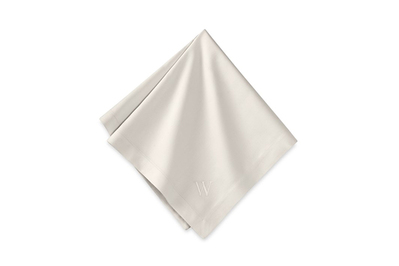
Williams Sonoma Hotel Dinner Napkin
The best cloth napkin
These soft and absorbent dinner napkins are finished with deep hems and clean stitching.

Williams Sonoma Hotel Tablecloth
The best tablecloth
This well-made tablecloth is available in eight sizes, and features a tight weave that gives it a structured drape
The Williams Sonoma Hotel Dinner Napkins and Tablecloth are as beautiful as they are functional. Made from 100 percent cotton fabric, they’re soft, smooth, and absorbent. Both the napkins and tablecloth are finished with deep hems and mitered corners that give your table setting a polished and seamless look. The dinner napkins are available in sets of six or 12, and in three neutral colors. The tablecloth comes in eight sizes, and most are available in the same three colors as the napkins.
Runner-up
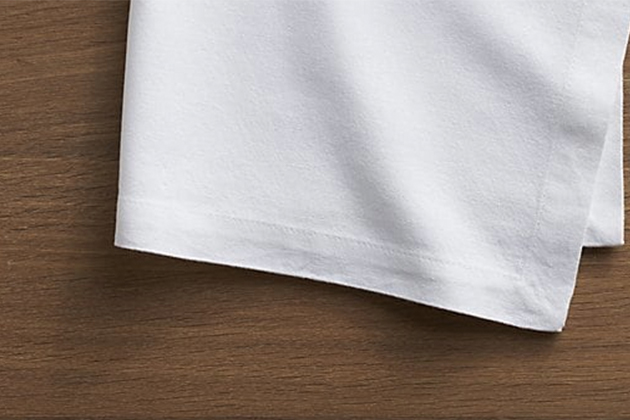
Crate and Barrel Abode White Cloth Dinner Napkin
For a more casual setting
Though slightly thinner than our top pick, these white cotton napkins are still soft and absorbent.
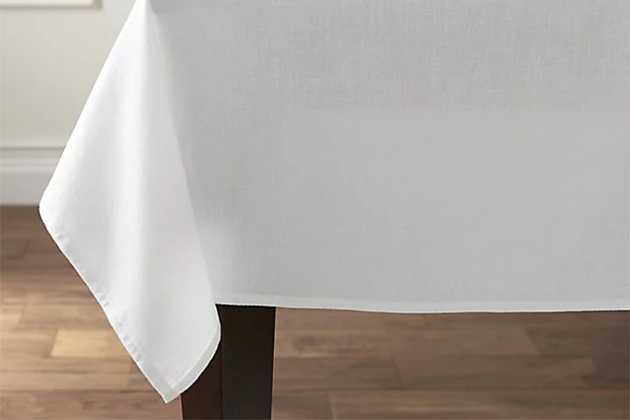
Crate and Barrel Abode White Tablecloth
For a more casual setting
The Abode tablecloth is a good choice if you’re looking for a more casual setting.
If our top pick sells out, the Crate and Barrel Abode set is a good runner-up at a comparable price. The individually sold napkins are soft, absorbent, and finished with deep hems and mitered corners. The tablecloth is available in five sizes and comes generously oversized to accommodate for shrinkage after laundering. Compared with our top pick, these 100 percent cotton table linens are made from thinner material with a looser drape. And unlike our top pick, this set is available only in white.
Budget pick

Crate and Barrel Fete Napkin
Value napkins in lots of colors
These inexpensive napkins come in 14 color choices, the most of all our picks.
The Crate and Barrel Fete cotton napkins are thin, but they’re also super absorbent and a great value. However, there isn’t a coordinating tablecloth to make a matching set like with our other picks. The Fete set is an affordable choice if you need enough napkins for a crowd.
Upgrade pick
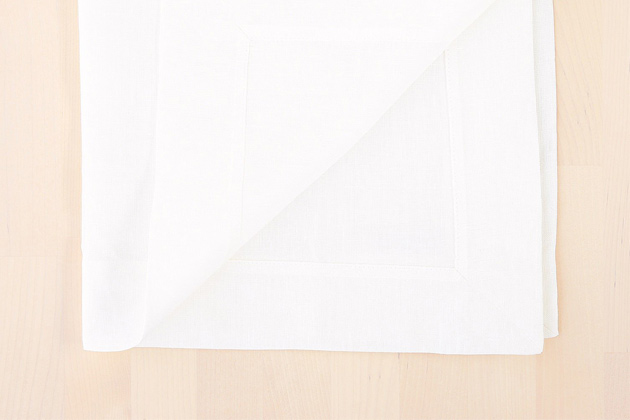
Rough Linen Smooth Napkin
The best linen napkin
Smooth and absorbent, this luxurious napkin is perfect for those who love the soft and relaxed texture of 100 percent linen.
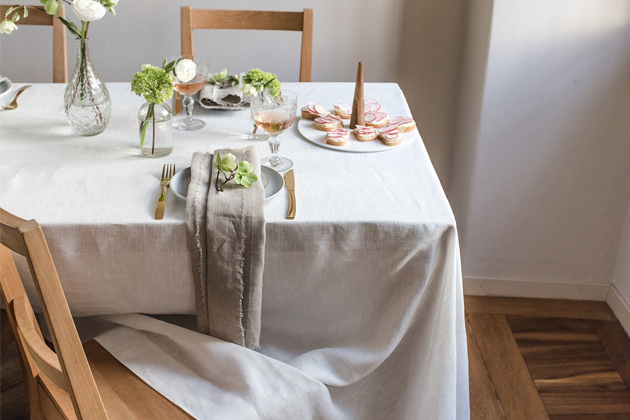
Rough Linen Smooth Tablecloth
The best linen tablecloth
Nothing comes close to the soft, relaxed drape of this 100 percent linen tablecloth. Yes, it’s expensive, but this tablecloth will last you a lifetime.
For those who love the look and feel of Belgian linen and don’t mind paying for quality, we think the Rough Linen Smooth Napkins and Tablecloth are a fantastic investment. These table linens are equally beautiful either rumpled for a dressed-down family dinner, or crisply pressed for special gatherings. Of all the linen napkins we tested, these are the softest and most absorbent. And the substantial fabric, deep hems, and expertly sewn mitered corners give this tablecloth a fluid and seamless look when it’s draped over your table. With proper care, we believe these heirloom-quality table linens will bring warmth and beauty to your meals for decades to come.
Everything we recommend
Our pick

Williams Sonoma Hotel Dinner Napkin
The best cloth napkin
These soft and absorbent dinner napkins are finished with deep hems and clean stitching.

Williams Sonoma Hotel Tablecloth
The best tablecloth
This well-made tablecloth is available in eight sizes, and features a tight weave that gives it a structured drape.
Runner-up

Crate and Barrel Abode White Cloth Dinner Napkin
For a more casual setting
Though slightly thinner than our top pick, these white cotton napkins are still soft and absorbent.

Crate and Barrel Abode White Tablecloth
For a more casual setting
The Abode tablecloth is a good choice if you’re looking for a more casual setting.
Budget pick

Crate and Barrel Fete Napkin
Value napkins in lots of colors
These inexpensive napkins come in 14 color choices, the most of all our picks.
Upgrade pick

Rough Linen Smooth Napkin
The best linen napkin
Smooth and absorbent, this luxurious napkin is perfect for those who love the soft and relaxed texture of 100 percent linen.

Rough Linen Smooth Tablecloth
The best linen tablecloth
Nothing comes close to the soft, relaxed drape of this 100 percent linen tablecloth. Yes, it’s expensive, but this tablecloth will last you a lifetime.
Why you should trust us
In addition to covering table linens for Wirecutter over the past three years, I also was a food stylist for many years. I worked closely with prop stylists to help choose the tableware that best evoked a particular mood. I learned to drape, fold, and rumple napkins and tablecloths from some of the most talented people in the business.
For this guide, we also interviewed textile experts Preethi Gopinath, adjunct professor at Fashion Institute of Technology, and Shannon Maher, chairperson of Home Products Development at FIT.
Who should get this

Whether you’re a dinner party pro or hosting a holiday meal for the first time, choosing a well-made and versatile set of table linens will elevate both last-minute gatherings and special occasions. A cotton or linen tablecloth and set of napkins are a warm and welcoming touch that instantly adds style to any table setting. Cleanly pressed white cotton table linens evoke the elegance of a fine-dining restaurant. A slightly rumpled linen tablecloth creates a warm and casual atmosphere perfect for a night in with friends.
Practically speaking, a tablecloth is a simple way to hide an old, beat-up tabletop. Linens are also a great way to easily and affordably change up your setting to match the occasion or your current mood. And cloth napkins aren’t only a nice detail, they’re a reusable alternative to paper that you can use every night of the week.
A table linen glossary
If you’re new to the wide world of tabletop goods, we compiled a short glossary of terms to help you shop for napkins and tablecloths like a pro:
Table linens: Fabric napkins and tablecloths are called table linens. This term has nothing to do with the fibers used to make these goods, so a table linen can be made from cotton, linen, or synthetic fibers like polyester.
Drape: The drape describes how a tablecloth hangs from the edges of the table or the way a napkin settles in your lap. Crisp, tightly woven cotton cloth will have a stiffer drape that looks refined and formal. Linen has a more relaxed, natural drape that lends well to casual and comfortable settings.
Drop: The length of the tablecloth that hangs down from the edge of the table is the “drop.” Your preferred drop length is personal taste, but we don’t recommend going shorter than 6 inches.
Mitered corners: A mitered corner is a 45-degree-angle seam where two sides of a napkin or tablecloth meet. Mitered corners have less bulk than standard overlapping hems, which gives them a sharp, clean look, and also allows them to be ironed relatively flat.

Puckering: The occurrence of little ripples along the hemline is called puckering. This usually shows after you’ve washed and dried your linens. Puckering can happen if the fabric and thread shrink at different rates, the stitch tension is too tight, or if the fabric wasn’t laundered before sewing. All of our linens puckered at various rates, but the worst offenders came out of the wash with rippled and fluttered hems that were impossible for us to iron flat.
Warp and weft: If you picture a loom you’ll see the threads run in two directions. In the simplest terms, the warp of the fabric is the lengthwise threads that are stretched taut on the loom. The weft is the crosswise threads woven in and out of the warp, and not attached to the loom at all. You can’t tell which is the warp and which is the weft of a fabric just by looking, but because of the difference in tension when it’s woven, the fabric will shrink more in the direction of the warp (about 5 percent) than the weft (about 3 percent).
How we picked

How you decide to set your table is mostly personal taste. Table linens are as subjective as any other design element in your home—to a point. No amount of ornate prints or embellishments can make up for cheap materials or bad workmanship. We looked for linen sets with tight weaves, attractive hems, and straight, even stitching. Tablecloths had to be available in at least three sizes, and napkins should be large enough for good coverage on your lap. We limited our search to linens available in white because it’s versatile and looks good with most decors. In all, we sought out sets with the following criteria in mind:
Material
It’s important to remember that dining at a well-appointed table is a feast for all the senses. For this reason, we immediately ruled out linens made from synthetic fibers like polyester or nylon, as well as poly-cotton blends, because they aren’t pleasant to wipe your face with or touch. While synthetics are more resistant to wrinkles and stains, we prefer table linens made from cotton or linen because these natural fibers feel good and absorb messes quickly. But the two fabrics have different qualities, and you may prefer one or the other depending on your needs.
The most common and affordable natural-fiber table linens are made from cotton. Prices vary depending on quality of the fiber, construction, and sometimes name brand. Cotton linens generally have the smooth, polished look of a fine-dining restaurant.
Linen, made from the fibers of the flax plant, is absorbent and has a more relaxed drape than cotton. Threads spun from flax fibers are thicker than cotton, and the result is the distinct visible woven texture that linen goods are known for. For more information about linen, see our guide to the best linen sheets.
Durability
Table linens are susceptible to a lot of wear and tear. Most people need to wash napkins and tablecloths after each use because of the inevitable spills and drips, and all those trips through the washer can cause poor-quality table linens to fray at the seams. We looked for clean hems and consistent stitching and avoided linens with loose threads or visible raw edges.
Sizes
Cloth dinner napkins should be generously sized to cover your lap. We found that napkins in the 19-to-20-inch range are ideal. Since dining tables vary widely in size and shape, there’s no general “sweet spot” for tablecloths. Instead, we focused our search on table linen sets that offered the most tablecloth size options.
To find the right size tablecloth for your dining table, you can reference this chart from Williams Sonoma, or use this handy calculator. Keep in mind that all table linens made from cotton or linen will shrink after laundering, around 5 percent in length and 3 percent in width. When buying a tablecloth, do the math so you don’t have any surprises after wash day.
Aesthetics and design
Table linens come in countless colors and patterns to suit every taste. Tabletop aesthetics are entirely subjective, and it would be impossible for us to find something to suit everyone. We decided to focus on well-made napkins and tablecloths in white because they’re neutral, and look clean and polished in any setting. But most of our picks are available in other colors.
Hems with clean, straight stitching and minimal puckering are a sign of a well-made product. Deep hems that measure at least 1 inch, and mitered corners on square or rectangular linens add weight to the drape and give tablecloths a polished drop. But round and oval tablecloths should be finished with a narrower hem, about a ¼ inch or ⅜ inch, to avoid puckering.
Shrinkage
You should expect your table linens to shrink after washing and drying (even after following the care directions on the label). A square napkin won’t come out of the wash a perfect square, since the warp yarns shrink more than the weft. As long as you can still neatly fold the napkin corner to corner without any overhang, you won’t notice the slight discrepancy in dimensions. A problem arises when the napkin is cut “off-grain” (meaning the cut and hemlines don’t follow the fabric grain), and you end up with a wonky-shaped napkin.
As we stated above in our sizes section, a tablecloth will shrink more lengthwise than widthwise (around 5 percent in length and 3 percent in width). For example, a rectangular tablecloth measuring 70 inches by 144 inches will probably shrink 2 to 3 inches in width, and 6 to 7 inches in length. Some companies oversize their tablecloths to accommodate for loss after washing, but there’s no way of knowing this unless you measure the cloth yourself before buying.
How we tested

Over the past four years of covering table linens for Wirecutter, we’ve spent more than 60 hours researching hundreds of napkins and tablecloths. For this update, we tested more sets from the company that makes our top pick (Williams Sonoma), a couple of budget-friendly cotton options, and 100 percent linen sets.
Since your table linens will probably need to be washed after each use, they need to stand up to the rigors of your washer and dryer. To test durability, we laundered the napkins and tablecloths five times and pressed them with a steam iron. We examined the fabric for pilling and the hems for puckering and fraying. We also measured each piece to gauge shrinkage after laundering.
We dabbed our faces and wiped our hands with each napkin to assess their softness and ability to quickly absorb moisture. I also placed each napkin in my lap throughout the workday, taking frequent breaks to handle it for softness and comfort. We draped the tablecloths over countertops, desks, and tables to examine the drape and drop of each one.
Our pick: Williams Sonoma Hotel Dinner Napkin and Tablecloth

Of all the cotton napkins we tested, the Williams Sonoma Hotel napkins had the thickest weave and felt the smoothest against our skin. They’re substantial, absorbent, generously sized, and a suitable barrier between small dinner-table mishaps and your outfit. In our tests, we found the 20-inch-square napkins shrink to measure 19½ by 18½ inches—which is normal for cotton. Unlike the cheaper brands we tested, the Williams Sonoma Hotel linens maintained straight hemlines after laundering and shrinking, allowing us to make neat, corner to corner folds. If white isn’t your style, these napkins are also available in ivory, charcoal gray, and red (12-piece set).
The matching Hotel tablecloth is made from the same cotton as the napkins, and the rectangular tablecloths have similarly deep hems and mitered corners. The round and oval tablecloths have a narrower hem, about ⅝ inch. Our 70-by-90-inch tablecloth showed normal shrinkage and measured 68½ by 84 inches after laundering. The Hotel tablecloth is available in a variety of sizes and colors to suit most people:
- 70-inch round (white and ivory)
- 90-inch round (white, ivory, charcoal gray, and red)
- Rectangular sizes 70 by 90 inches, 70 by 108 inches, 70 by 126 inches, and 70 by 144 inches (white, ivory, charcoal gray, and red)
- 70-by-90-inch oval (white and ivory)
- 70-by-126-inch oval (white only)
With proper care and storage, the Hotel table linens will serve you well for years to come. For stain removal, laundering, and storage tips, check out How to keep your linens looking like new.
Flaws but not dealbreakers
Since this set is made from 100 percent cotton fabric, it will wrinkle after laundering. Ironing is an unavoidable task when using natural-fiber table linens. If you love to iron, great! If you hate ironing with a passion, take your linens to get laundered and pressed by a professional. We think this is a small price to pay for soft cotton table linens.
Runner-up: Crate and Barrel Abode Napkin and Tablecloth

Runner-up

Crate and Barrel Abode White Cloth Dinner Napkin
For a more casual setting
Though slightly thinner than our top pick, these white cotton napkins are still soft and absorbent.

Crate and Barrel Abode White Tablecloth
For a more casual setting
The Abode tablecloth is a good choice if you’re looking for a more casual setting.
If our top pick sells out, the Crate and Barrel Abode White Cloth Dinner Napkin and Tablecloth are an attractive set of table linens for about the same price. The set is 100 percent cotton and the dinner napkins are finished with a deep hem and mitered corners, which give them a more seamless look. Compared with our top pick, the Abode linens are a bit thinner with a more open weave, available only in white, and the tablecloths have narrower, ⅝-inch hems with overlapping corners. But the napkins are sold individually, so you can get exactly the amount you need, and the tablecloth is available in five sizes, including a square and round shape.

Even though we prefer a deep hem on square and rectangular tablecloths, the narrow hem and overlapping corners on the Abode tablecloth are finished well and will press flat with a steam iron. The open texture of the Abode cotton gives these linens a more relaxed and casual look than our top pick tablecloth, so if the Williams Sonoma Hotel Tablecloth is a little too crisp and formal for you, the Abode collection might be a perfect choice. Our 60-by-120-inch tablecloth measured 63 by 121 inches after laundering.
The Crate and Barrel Abode tablecloth is available in 60-inch square, 90-inch round, and oblong sizes of 60 by 90 inches, 60 by 120 inches, and 60 by 144 inches.
Budget pick: Crate and Barrel Fete Napkin

Budget pick

Crate and Barrel Fete Napkin
Value napkins in lots of colors
These inexpensive napkins come in 14 color choices, the most of all our picks.
The Crate and Barrel Fete Napkin is crazy inexpensive and super soft, and comes in 13 colors. At $3.50 per napkin (when bought in a set of eight), you won’t care if they get splashed with red wine. (But if they do get trashed, check out our tips for stain removal.) The Fete napkin is very absorbent and has a tighter weave and a softer feel than the Abode linens. But the Fete is also thinner and has an extremely limp drape, even when folded. That said, you can’t beat the price for a set of cotton napkins.
Upgrade pick: Rough Linen Smooth Napkin and Tablecloth

Upgrade pick

Rough Linen Smooth Napkin
The best linen napkin
Smooth and absorbent, this luxurious napkin is perfect for those who love the soft and relaxed texture of 100 percent linen.

Rough Linen Smooth Tablecloth
The best linen tablecloth
Nothing comes close to the soft, relaxed drape of this 100 percent linen tablecloth. Yes, it’s expensive, but this tablecloth will last you a lifetime. Even though a set of Rough Linen is a big investment, it’ll likely last a lifetime and beyond with proper care and storage.
Rough Linen’s cloth is the most beautiful, absorbent, and luxurious of all the 100 percent linen napkins we tested. Despite the name, the Rough Linen is soft to the touch and lays comfortably in the lap. It features the deepest hem of all the competition (just under 2 inches), and it pressed perfectly flat and puckered the least after laundering. Other little details like double-stitched hems and expertly sewn mitered corners with perfectly symmetrical seam allowance set this napkin apart from the competition
Our 24-inch-square napkin measured 22½ by 23¾ inches after five trips through the washer and dryer. The Rough Linen Smooth napkins are sold individually and come in two sizes (20-inch and 24-inch squares), and two colors (white and natural).
The Rough Linen tablecloth has a beautiful, relaxed drape, generous 3-inch hem, and pointy mitered corners. Other linen tablecloths we tested were so thin we could practically make out the details of the table underneath, while Rough Linen’s tablecloth gave us the most opaque and seamless coverage. Our 60-inch-square tablecloth shrunk to 57 by 59 inches after laundering and ironing. It’s available in three sizes (60-inch square, 72 by 118 inches, and 90 by 144 inches) and two colors (white and natural).
Even though linen has a reputation for wrinkling easily, we had little issue pressing these with a steam iron. The added bonus with linen is that you can work out creases with a clothing steamer if you’re going for a more rumpled, casual look. It’s important to note that the white color is warm and soft. If you’re looking for bright-white table linens, our top pick is your best bet.
How to keep your linens looking like new
Stain removal
The best line of defense against stains is water. Start by running the stained area under running cold tap water to flush out as much of the discoloration as possible. Next, treat the stain with the right solution for the job:
Grease: Turkey drippings, butter, vinaigrette, or anything cooked in oil will leave a grease stain. The first step with grease is to treat the spot with dish soap, liquid hand soap, or liquid laundry detergent and a few drops of water to help work the product into the stain. After laundering the item, always let it air-dry because the heat from your dryer will set the stain permanently. Kerr told us: “Don’t even take the risk of putting it in the dryer, because a wet item will obscure a lingering grease stain.” Her advice is to, “Air-dry, then check to see if [the stain is] gone. If not, just retreat it. Sometimes just a second washing is required.”
Blood: Almost anything will get a bloodstain out, but it’s important to use cold water, because hot water can set the stain. Using hand soap, apply a generous amount to the spot and rub vigorously until it’s mostly out. Launder in cold water and air-dry.
Red wine, coffee, tea, and berries: For small spots and splatters, douse the stain with Wine Away and let it sit for at least five minutes before laundering in cold water. If the stain persists, move to the next step.
For large or stubborn stains, prepare a soak with oxygenated bleach (we used Clorox Oxi Magic) and hot tap water. Let your soiled linen soak for at least one hour, then launder in cold water and air-dry.
Lipstick: Dab lipstick stains with a cotton ball soaked in isopropyl alcohol. This might take a few passes, but the color will lift. Rub the area with liquid laundry detergent before laundering in cold water. Be sure the stain is completely out before tumble-drying the item.
Wax: Lifting candle drippings from your tablecloth is a different ball of wax (puns!). In an email follow-up, Kerr explained both hot and cold methods for removing wax:
“The hot method involves using an iron on the lowest heat setting and brown paper; lay the paper over the wax and apply the iron. The heat will melt the wax, which will then be absorbed by the paper. Rotate the paper as the section you’re working with becomes saturated with the wax, and increase the heat if the wax isn’t melting enough to absorb into the paper.
“The cold method involves freezing the waxed item, either by placing it in the freezer or by applying ice cubes or packs to the wax. As it freezes, the wax will contract, making it easy to pop right off the textiles using a fingernail, spoon or butter knife (don’t use anything sharper than a butter knife, as you can nick the fabric causing a hole).”
Keeping your whites bright
Keeping the white table linens their brightest is all about product moderation. Most laundry detergents available these days are highly concentrated, and you don’t need to use much to get your linens clean. And since high-efficiency machines use less water, your chance of residue buildup increases. Kerr suggested using the extra rinse function on your washer: “The great thing about the extra rinse is that people don’t realize how much product buildup affects the look, in terms of dinge. And the extra rinse is what’s gonna keep your whites white.”
Storage
The best way to store your linens is in a dark, dry place (like a linen closet or drawer). If you want to take an extra step to protect your napkins and tablecloths, wrap them in acid-free tissue paper and store in archival boxes. Never store your linens in plastic or cardboard. The compounds from those materials can migrate to the fabric and cause a chemical reaction that turns it yellow.